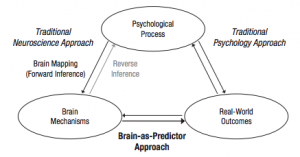Psychologists aim to better understand the link between internal and external states, that is, between cognitions and behaviors. Behaviors are often clear enough to measure, but accurately capturing the essence of a cognition can be a much fuzzier task.
For instance, suppose you were interested in the relationship between how much someone enjoys rewards (reward sensitivity) and that individual’s degree of success in quitting smoking. The quitting behavior could feasibly be measured in a number of ways—number of cigarettes smoked per day, number of actions taken to quit (e.g., buying a patch), length of time taken to quit, etc. However, how to measure reward sensitivity isn’t quite as clear-cut. You could ask people how much they like a reward you’ve provided or how much they are willing to pay for it, but people can be inaccurate when attempting to introspect at this level.
Enter neuroimaging. With steady technological gains over the last several decades, we’re now able to measure many cognitive processes such as reward sensitivity with a relatively high level of granularity. However, neuroscience typically does not answer questions about the cognition-real world behavior link because the traditional neuroscience approach has focused on having subjects complete tasks in the lab and seeing how their brains respond, i.e., brain mapping. So, for instance, researchers interested in how fear is processed might show subjects frightening images and see which regions of the brain show activation increases in turn.
Elliot Berkman and Emily Falk, recent graduates of the UCLA psychology doctoral program, suggest that there is another method whose potential has yet to be tapped, which they call the brain-as-predictor approach. Using this method in the smoking cessation example, researchers might see whether greater reward sensitivity (via activation patterns in regions associated with reward processing such as the nucleus accumbens or ventral tegmental area during reward administration) affects smoking cessation success.
The authors review several lines of work that have used the brain-as-predictor approach— including domains as varied as consumer behavior, health, and skill learning—and explain how the approach can be leveraged for more widespread use.
Interested in learning more? Check out the article in full here.
